

Great Picture Books to Use for Words of the Wiser – Notice & Note. One of the main texts we use to guide our reading instruction is the amazing Notice and Note: Strategies for Close Reading by Kylene Beers and Robert Probst.

This book provides us with the foundation for having deeper reading conversations and a common language as we develop our thoughts. While the book has excellent text ideas to use as mentor texts, I thought it would be nice for my students to use picture books on the very first day of a new strategy before we delve into the longer text excerpts. I have therefore looked for picture books I could use with the different strategies and will publish posts as I have them for the 6 different strategies since I cannot be the only one looking for ideas.
The first post was on Contrast & Contradictions, then followed Aha Moments, then Tough Questions, and now Words of the Wiser – a great strategy for noticing when life advice is given. Three Ways of Assessing Students' Understanding Through Mobile Phones. Great Picture Books to Teach Theme. I need to apologize.

This post will be the longest one yet with the most suggestions of which picture books to use for something. The Kids' Guide to Google Search. Habit Stacking in the Classroom (10 Smart Ways to Boost Learning) When we look at what research says about becoming better at something, two pieces of evidence stand out.
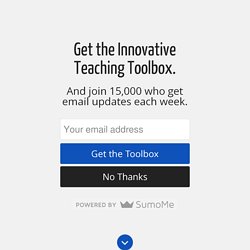
First, we must have clarity on what our goals are, and where we want to go or what we want to become. Second, it is deliberate practice (combined with feedback loops) that increase the myelin in our brain and in turn help improve performance and growth. Today I want to talk about a process that we often miss when look at student success in the classroom. We tend to talk about growth, goals, and instructional practice…yet, we miss a key element of going from “defining a goal” to “achieving a goal” with out students.
It’s about building better learning habits. We often talk about strategies, but forget that our habits as teachers and leaders impact the habits of our students. Students only become better at writing through deliberate practice, and feedback on the practice. Here’s where habit stacking becomes essential in our classrooms. What is Habit Stacking In S.J. 1. 2. Creating the Classroom Conditions for the Best Day Ever. Lately, I have become a little obsessed with idea of the best day ever.
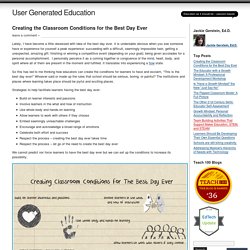
It is undeniable obvious when you see someone have or experience for yourself a peak experience: succeeding with a difficult, seemingly impossible task; getting a unexpected, amazing gift; finishing or winning a competitive event (depending on your goal); being given accolades for a personal accomplishment. I personally perceive it as a coming together or congruence of the mind, heart, body, and spirit where all of them are present in the moment and fulfilled. 4 Ways Visual Literacy is Being Taught in Classrooms to Empower Learning. How to Incubate Creativity in School Through Making and Discovery. Sixth-grade students at Lighthouse Community Charter in Oakland, California, eagerly pull laptops off a cart and settle down with a partner to experiment with Turtle Art, a program meant to introduce them to the basics of programming and some math concepts.
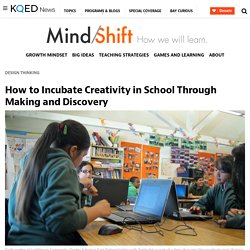
Math teacher Laura Kretschmar gave students a rubric with specific goals around collaboration, communication and instructions to use various functions in the program, but not a lot else. She’s intentionally giving them a lot of freedom to play with the program, create cool designs and figure out what the functions do. “I think “y” means, like, going up,” says Juritzy Maldonado. Classroom Management: The Intervention Two-Step. All of us have had major classroom disruptions that try our patience and push our limits.

These incidents can threaten our sense of control and generate fear of looking weak to other students. We fear that other students might do the same thing if we don't take a strong stance. How to get students to follow directions the first time. By this point in the school year, you’re probably having some moments when you feel like you’ll lose your mind if you have to repeat yourself one. more. time.
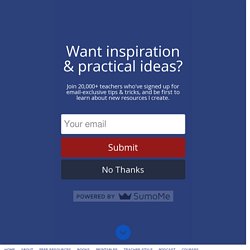
Some of you have probably felt like that since September! And that’s perfectly normal. A big part of a teacher’s job is teaching students to listen, follow directions, and be self-directed and independent in their work, and that means LOTS of repetition and reinforcement. How to get students to follow directions the first time. Techdiva29. 5 Alternatives to Think-Pair-Share for Classroom Discussion. Editors Note: Originally this blog featured five alternates to think-pair-share in classroom discussion.
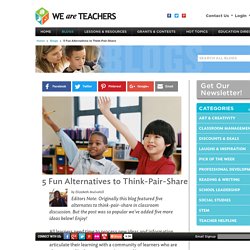
But the post was so popular we've added five more ideas below! Enjoy! 5 Alternatives to Think-Pair-Share for Classroom Discussion. Genius Hour: An Apprenticeship to Citizenship - Angela Maiers. “Let’s change the world!!”
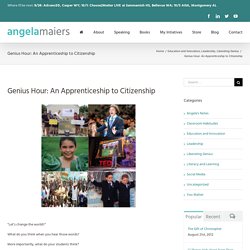
What do you think when you hear those words? More importantly, what do your students think? For most, “Let’s change the world” is a mere slogan, or a battle cry that gets the heart racing and blood flowing. 15 Topics for Your School/ Classroom Blog. How can you use Twitter to shape your learning? How can you use Twitter to shape your learning?

Public domain image via Pixabay. Rebecca's Restitution Resource. Secret Coders: Lost & Found. In Gene Luen Yang’s latest project, programming takes center stage, as he creates a preliminary introduction to coding through the adventures of three schoolkids. A missing dog? This is clearly a job for… the Giant Flying Laser Turtle! But will Eni, Hopper, and Josh be able to figure out how to control the turtle so that no one (including the dog) gets shot with a laser? Find out below in the Tor.com Original Comic “Lost & Found”! The Secret Coders series is the first collaboration between author Gene Luen Yang and artist Mike Holmes. Swipe to navigate. M.fastcompany. Ask a 10-year-old how to solve the problem of cleaning up trash, and you might end up with a concept like the "De-Waster 5000," a helicopter that scoops plastic out of landfills and the ocean—and then uses a solar-powered flamethrower to melt the trash into beds for homeless people.
In other words, you'll get something that probably wouldn't occur to an adult designer. The De-Waster was one of the prototypes created in the Global Childrens' Designathon on November 15, which invited kids in five cities to spend a day designing solutions to improve food, waste, or mobility issues in their hometowns. For the designers behind the workshop, the event was a way to introduce children to skills they probably aren't learning in the classroom. "A big impetus for the project is the way children learn or don't learn," says Emer Beamer, founder of Unexpect, a Dutch agency that focuses on teaching children how to use design to tackle global challenges. Project Based Learning. Project Based Learning / Project work. PBL - Project Based Learning. General classroom resources. Flipped Classroom. Bloom's Taxonomy For Cognitive Learning and Teaching.
The Flipped Classroom: Turning the Traditional Classroom on its Head. Resources for Teaching Digital Literacy. Search Tools Search is the essential 21st century skill. Developing search literacy in students should be the priority of our education. Teachers and students need the ability, search tools and strategies to effectively mine for information, evaluate and validate information. FindingEducation, it’s for teachers to find best education resources on the web , backed by FindingDulcinea’s hand-selected and professionally edited education resource library. Teachers can manage, organize and share their links, and create web-based assignment their students. Check out this Web search tutorial called “Ten Steps to Better Web Research” by SweetSearch, this presentation provides background, reference material: Teaching the Ten Steps to Better Web Research.
K-12 Education Tips & Strategies That Work. A Project-Based Learning Spectrum: 25 Questions To Guide Your PBL Planning. A Project-Based Learning Spectrum: 25 Questions To Guide Your PBL Planning by Terry Heick I’ve been talking with a friend recently about project-based learning, which is leading to a TeachThought Project-Based Learning framework hopefully sometime next week. (Or whenever I finally get this TeachThought podcast off the ground–maybe Tuesday? Responsive Classroom. The Assessments that Matter Most Can Never Be Standardized. Stuckey in Second: Close Reading with Oreos {by Primary Polka Dots} What a fun day! My team and I heard about this awesome OREO cookie lesson from the third grade teachers at our school and of course, since it involved OREOs, we had to try it!!
It was just one of those awesome lessons, better than I thought it would be. It made my whole day! (Even if the kids had been eating Oreos!) For the full lesson, see Lindsay's store at Primary Polka Dots for her Close Reading lessons. Here is how it went in my room today!!! First, I passed out one cookie to each student. After some weird looks from the kids (Did I mention this was at 9:45 in the morning?) Obviously, their responses were Oreo cookie, oreo, and one kid actually said Vanilla Wafer (gotta love it!)
Next, I passed out ANOTHER Oreo (could it be true!?) Look at the cookie carefully.Smell the cookie.Think about the cookie.Eat the cookie VERY slowly with your eyes closed, thinking about every bite you take.Think about the texture and the taste of the cookie while you are eating. Classroom Observation.